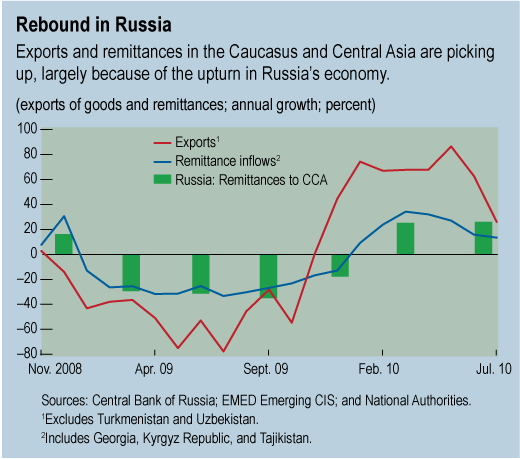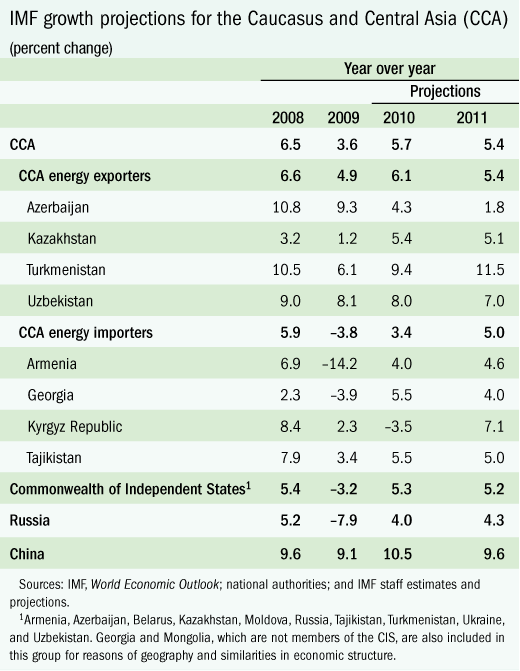
Typical street scene in Santa Ana, El Salvador. (Photo: iStock)
IMF Survey: Recovery Takes Hold in Caucasus, Central Asia
October 28, 2010
- Russia's rebound has positive impact on region
- Countries should wind down fiscal stimulus and crisis-related measures
- Banking sectors still pose risk in some countries
The economic upturn in the Caucasus and Central Asia is gathering momentum, with growth for the region projected to increase to 5¾ percent in 2010 from 3½ percent in 2009, a senior IMF official said.

Worker picks cotton in Uzbekistan, one of the fastest-growing countries in the Caucasus and Central Asia region (photo: Shamil Zhumatov/Reuters)
REGIONAL ECONOMIC OUTLOOK
David Owen, Deputy Director of the IMF’s Middle East and Central Asia Department, told a press conference in Almaty, Kazakhstan, that the fiscal stimulus applied by many governments in the region—together with a favorable external environment—had helped spur the recovery from the global crisis. The upturn in Russia’s economy has benefited the region, mainly through trade and remittance channels (see chart), as has the rise in oil prices.

“The outlook for the region is broadly positive, although in some countries it will take time for per capita disposable income to return to pre-2009 levels,” Owen said.
Countries in the Caucasus and Central Asia differ substantially in terms of per capita GDP, which ranges from under $700 in Tajikistan to $7,000 in Kazakhstan. Half of the region’s countries are exporters of oil and gas (Azerbaijan, Kazakhstan, Turkmenistan, and Uzbekistan), while the others are importers (Armenia, Georgia, the Kyrgyz Republic, and Tajikistan).
Sustained growth for energy exporters
The IMF’s Regional Economic Outlook for the Middle East and Central Asia says that growth in 2010 is expected to be strongest among the region’s oil and gas exporters, with projections ranging from 4½ percent in Azerbaijan to 9½ percent in Turkmenistan (see table). With oil prices expected to remain near $80 per barrel in 2011, these countries should grow at similar rates in 2011.
Among the oil and gas importers, Armenia and Georgia are forecast to grow at 4 percent and 5½ percent, respectively, in 2010, compared with negative growth in 2009. In Tajikistan, growth is estimated at 5½ percent for 2010—about 2 percentage points higher than in 2009. Buoyed by Russia’s recovery, all three countries are projected to grow at 4–5 percent in 2011, the IMF report says.

In the Kyrgyz Republic, political and ethnic turmoil earlier in the year are weighing heavily on this year’s performance. Economic activity is expected to shrink by 3.5 percent in 2010, but bounce back strongly in 2011 and grow by a projected 7 percent.
Inflation across the region as a whole has come down from high pre-crisis levels, and underlying inflationary pressures are expected to remain contained over the next year, the IMF report says. In a few countries, however, headline inflation has been impacted significantly by the recent spike in food—especially wheat—prices, and policymakers will need to monitor developments closely. In Uzbekistan, continued fiscal stimulus, combined with lower interest rates and directed lending, raise the risk of a further buildup in inflationary pressures—a possibility that Turkmenistan also faces.
The Regional Economic Outlook notes that, while recovery appears to be on track, risks remain. In particular, a weaker-than-expected recovery in Russia would adversely affect trade and remittance flows to the region. Slower-than-expected growth in advanced economies would also weaken economic activity in the region, mainly through a drop in demand for oil and gas. And continued banking sector weaknesses could hold back credit growth and weigh on the economic outlook.
Policy response
With recovery on a firm footing, countries across the region can start winding down policies that were implemented in response to the crisis, the IMF report recommends. The authorities should first exit from fiscal stimulus, in light of fiscal sustainability considerations. This is particularly true for oil and gas importers, which are facing rising public debt as a result of their policy response to the crisis and declining donor support.
Monetary policy can remain accommodative for now, not least because banking sectors in many countries remain impaired—particularly in Kazakhstan, the Kyrgyz Republic, and Tajikistan, where there are high levels of nonperforming loans. At the same time, the authorities need to pay close attention to inflation developments and act quickly, if necessary, to prevent an increase in inflation expectations.
Comprehensive and transparent resolution strategies to tackle high NPLs would help spur a recovery in credit growth, and stricter lending standards would help prevent a recurrence of the nonperforming loans problem.
In the region’s oil and gas importers, current account deficits remain high, especially in Georgia and Armenia. Foreign direct investment inflows in most countries have not yet returned to pre-crisis levels, and external debt is high and rising. Going forward, policymakers should therefore focus on reining in current account deficits to help preserve external sustainability.
For the region’s oil and gas exporters, the medium-term policy challenge will be to develop the non-oil economy while managing their hydrocarbon wealth wisely.


